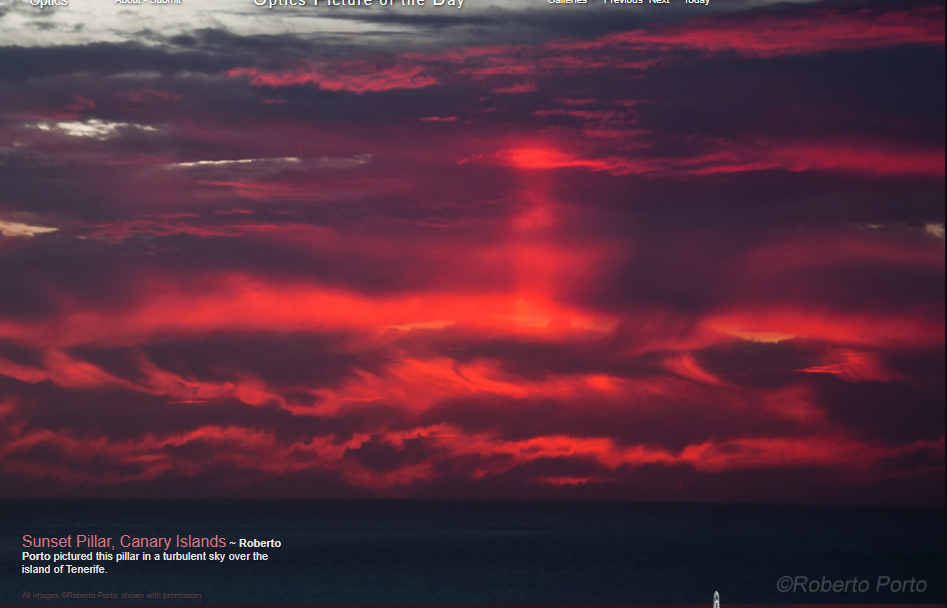Tenerife Sunset Pillar- OPOD
Tenerife Sunset Pillar: A Mesmerizing Atmospheric Phenomenon
Have you ever witnessed a sunset pillar? These awe-inspiring pillars of light can be seen in the sky during sunrise or sunset, and they create a magical and ethereal atmosphere. One such stunning example was captured by Roberto Porto above the picturesque island of Tenerife in the Canary Islands. In this article, we will delve into the captivating world of sunset pillars, exploring their formation, the science behind them, and the research that has shed light on their mysterious nature.
Unraveling the Science Behind Sunset Pillars
The traditional explanation for sunset pillars involves millions of plate-shaped ice crystals that reflect sunlight. These crystals, which are slightly tilted from the horizontal plane, collectively create an illusion of an upward pillar of light. However, this explanation raises several intriguing questions. Why do these wobbly crystals create a pillar shape instead of a broader blur? Why are sunset pillars predominantly observed near sunrise or sunset? And why is the pillar not brighter when closer to the sun?
In the early 1970s, Robert Greenler, a researcher faced with these perplexing questions, decided to put this explanation to the test through direct computation. Utilizing computer simulations and ray tracing techniques, Greenler and his students meticulously analyzed the reflections from various representations of wobbly mirrors. Each ray of reflected light formed a tiny black dot on a simulated "sky." To their astonishment, these dots converged to form sun pillars akin to those observed in nature.
The Birth of Computer Simulations for Ice Halos
Greenler's groundbreaking work marked the birth of computer simulation for ice halos using ray tracing techniques. This innovative approach provided a scientific foundation to investigate and understand the formation of various atmospheric optical phenomena. Gone were the days of relying solely on arm-waving explanations; now, science had a powerful tool to explore and unravel the mysteries of the natural world.
The initial simulations conducted by Greenler and his students revealed fascinating insights. When the simulated sun was just a few degrees above the computer's "horizon," the results showcased a prominent lower pillar and a smaller upper pillar. However, as they experimented with different sun elevations and crystal tilts, the situation transformed dramatically. The upper sun pillars exhibited their most captivating display when the sun was at or below the horizon. Moreover, these pillars could persist for some time after sunset, gradually shifting along the horizon as the hidden sun set beneath it.
A Deeper Understanding of Atmospheric Optics
Greenler's research not only shed light on the formation of sunset pillars but also paved the way for further investigations into other types of crystal formations and halos. The advent of computer simulations through ray tracing enabled scientists to explore a multitude of atmospheric optical phenomena with unprecedented precision and accuracy. By simulating different crystal shapes, orientations, and atmospheric conditions, researchers gained invaluable insights into the intricate workings of these captivating natural spectacles.
Through their studies, scientists have discovered that various factors influence the appearance of sunset pillars. These factors include the shape and orientation of ice crystals, the angle of the sun, and atmospheric conditions such as humidity and temperature. Each combination of these variables creates unique patterns and displays, contributing to the breathtaking beauty of sunset pillars.
Unlocking the Beauty of Sunset Pillars
Witnessing a sunset pillar is an experience that evokes wonder and awe. As the sun dips below the horizon, the sky transforms into a canvas painted with vibrant hues, and the pillar emerges as a pillar of light piercing through the atmosphere. Its ethereal glow creates a sense of tranquility and captivates viewers with its enchanting beauty.
The intricate science behind sunset pillars enriches our understanding of atmospheric optics and serves as a reminder of the complexity and splendor of nature. As researchers continue to delve into these phenomena, new insights and discoveries await, promising to unravel even more of the captivating secrets hidden within the atmospheric realm.
So, the next time you find yourself gazing at a breathtaking sunset, keep an eye out for the elusive sunset pillar. Let its enchanting presence remind you of the wonders that lie beyond our reach and the endless mysteries waiting to be unraveled in the captivating world of atmospheric optics.

Sunset Pillar, Canary Islands ~ Roberto Porto pictured this pillar in a turbulent sky over the island of Tenerife.
All images ©Roberto Porto, shown with permission

The arm waving explanation for sun pillars is that they are direct reflections from millions of plate-shaped ice crystals wobbling a few degrees from horizontal. Their glints towards the eye look collectively like an upward pillar of light.
But is that convincing? Why would wobbly crystals give that shape rather than a much wider blur? Why are they only seen near sunset or sunrise? Should the pillar not be brighter nearer the sun? Should the lower pillar not be brighter than the one above the sun?
Faced in the early 1970s with these and more questions from a student, Robert Greenler decided to test the explanation by direct computation.
They ray traced reflections from computer representations of wobbly mirrors. Each reflected ray of light formed a little black dot on the ‘sky’ of an ancient plotter. The thousands of dots formed sun pillars like those observed. Greenler and his students went on to investigate whether other crystals could form pillars. They then moved on to investigate other halos.
This was the birth of computer simulation of ice halos by ray tracing. Arm waving is not sufficient for science.

One the first simulations. The 'sun' is a few degrees above the computer's 'horizon'.
It revealed a large diffuse lower pillar and a diminutive upper one.
The situation changed as Greenler and his students tried other sun elevations and crystal tilts.
Upper sun pillars are at their best when the sun is at the horizon or below it. the latter can be followed for some time after sunset, creeping along the horizon and following the hidden sun.

Note: this article has been automatically converted from the old site and may not appear as intended. You can find the original article here.
Reference Atmospheric Optics
If you use any of the definitions, information, or data presented on Atmospheric Optics, please copy the link or reference below to properly credit us as the reference source. Thank you!
-
<a href="https://atoptics.co.uk/blog/tenerife-sunset-pillar-opod/">Tenerife Sunset Pillar- OPOD</a>
-
"Tenerife Sunset Pillar- OPOD". Atmospheric Optics. Accessed on April 19, 2024. https://atoptics.co.uk/blog/tenerife-sunset-pillar-opod/.
-
"Tenerife Sunset Pillar- OPOD". Atmospheric Optics, https://atoptics.co.uk/blog/tenerife-sunset-pillar-opod/. Accessed 19 April, 2024
-
Tenerife Sunset Pillar- OPOD. Atmospheric Optics. Retrieved from https://atoptics.co.uk/blog/tenerife-sunset-pillar-opod/.